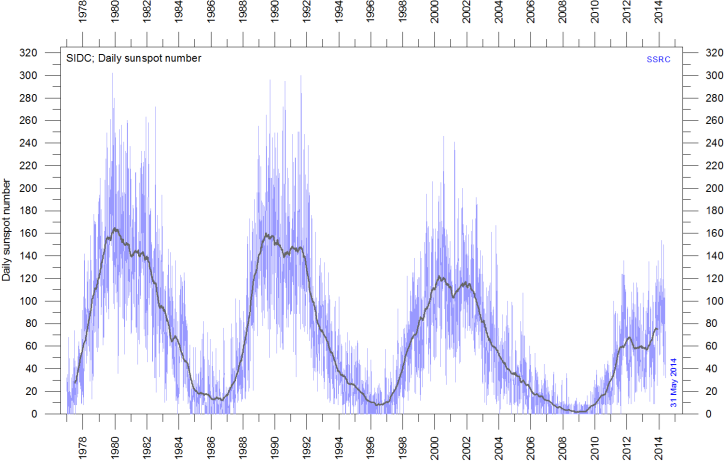The Global Climate Status Report of December 10, 2014 Summary Report, from the Space and Science Research Corporation says the following:
The Earth is presently in a sustained phase of GLOBAL COOLING though moderated by recently past peak of solar heating during solar cycle #24. Though there is new evidence of a reduction in this rate during the 2013-2014 period, the rate of temperature decline on a 100 year trend line is the steepest seen during that time frame going back to 1914. We conclude that the past period of global warming, as a natural phase of climate variation caused by the Sun, has ended, and a new cold climate epoch has begun.
The following chart is taken from the full report:
It is clear from this chart that the current sunspot cycle is much less active than the three preceding ones. I quote from the report:
There are four important observations one can draw from this chart:
- Of the solar cycles displayed (cycles 21, 22, 23, and 24), solar cycle 24 in total is noticeably the weakest as was predicted by me in 2007.(my emphasis) NASA has recently confirmed that it is the weakest cycle in 100 years.
- Each solar cycle contains two small peaks at the top of the cycle averaged over a specific period and shown by the dark blue line. The majority of all 24 numbered solar cycles since the first which peaked around 1761 have shown this hallmark and also shown that the first of the two peaks is the strongest.
- Solar Cycle #24, however, is the only one in the figure that has a much stronger average peak during the second peak, and hence represents a more active Sun with concurrent increased heating of the Earth.
- Sunspot activity for the secondary peak of cycle #24 shows sunspot counts at levels approaching some years of peak activity of solar cycle 23 that reached its maximum between 2000 and 2002. Global atmospheric temperatures for the 2013-2014 and 2000-2002 were in the same range of warmth according to SSRC and other global temperature data sets.
Also this:
A comparison of past solar cycles with the current behavior of solar cycle #24 thus indicates that the next two solar cycles (#25, #26) are likely to produce another cold epoch similar to that of the last solar hibernation between 1793 and 1830. The increased solar activity measured by sunspots and thus global heating observed from 2013 to 2014 may be viewed as yet another repeat of past solar activity that underscores the predictability of solar cycle models for climate variation while providing added support for the SSRC prediction of a new cold climate. We continue therefore, to expect that this new climate will bring cold weather for decades similar or colder than that witnessed during the solar hibernation of 1793 to 1830.
So again, rather than indicate that a renewal of global warming is in the offing, the recent brief two year rise in global temperatures between 2013 and 2014, is in fact, another signal of the coming cold climate. We are at the precipice of a plateau of global temperatures that has been with us for almost twenty years and are about to drop steeply as is explained in the press release posted after this section of the GCSR.
The new predictions made in this release may be among the most important I or the SSRC have made since 2007 when I began my quest to get our people prepared for the next climate change by correctly predicting the end of global warming and the start of a new cold climate. The specific timing of the next major global temperature drop is spelled out in this press release.
As stated above, John L. Casey, President, Space and Science Research Corporation, predicted the current quiet sunspot cycle in 2007.
I don’t need to tell you how much this varies from the stories we hear from the IPCC and their global media mouthpieces about anthropogenic global warming and how we are to blame for it, their story to justify the globalist’s horrendous and life-changing plans called Agenda 21. And I’m sure you didn’t hear about this report from the media.


Recent Comments